Key takeaways:
- The anti-death penalty movement is rooted in the belief in the sanctity of life and highlights fatal flaws in the justice system, including systemic biases against marginalized groups.
- Community mobilization is vital, as it fosters relationships, amplifies voices, and sustains pressure on decision-makers, ultimately contributing to a collective push for change.
- Engaging the community through storytelling, interactive events, and compelling messaging can evoke empathy and inspire action against capital punishment.
- Collaborating with local stakeholders and incorporating art into community events can strengthen advocacy efforts and raise awareness effectively.
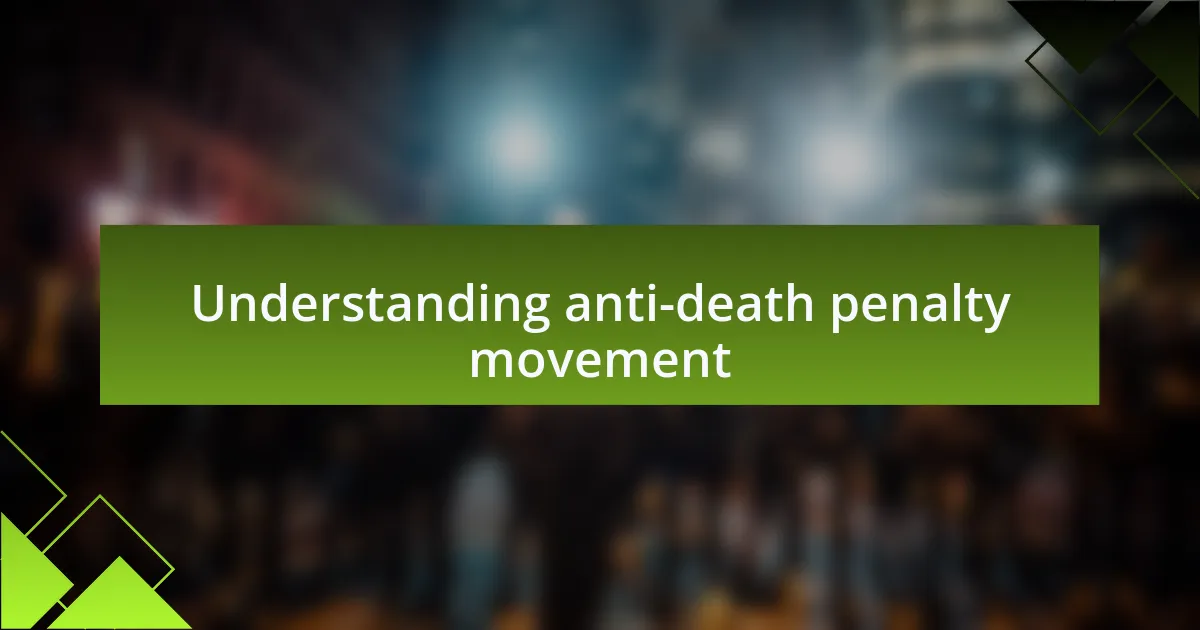
Understanding anti-death penalty movement
The anti-death penalty movement is grounded in a profound belief in the sanctity of life. I remember attending a vigil for someone wrongfully executed; the emotions in that space were overwhelming. It made me question: how can we justify taking a life when so many mistakes can happen within our justice system?
At its core, this movement challenges the efficacy and morality of capital punishment. I once spoke with a former death row inmate whose story brought tears to my eyes. Hearing how he fought to prove his innocence made me realize the human impact behind the statistics often debated in legal circles. It’s not just numbers; these are lives filled with potential and stories untold.
Another critical aspect lies in the inherent biases that affect who is sentenced to death. Engaging in discussions with community members, I found many were unaware of the systemic inequalities that plague this process. How is it that one’s race or socio-economic status can determine their fate? These conversations drove home the reality that our justice system isn’t just flawed but deeply unfair, highlighting the urgent need for change.
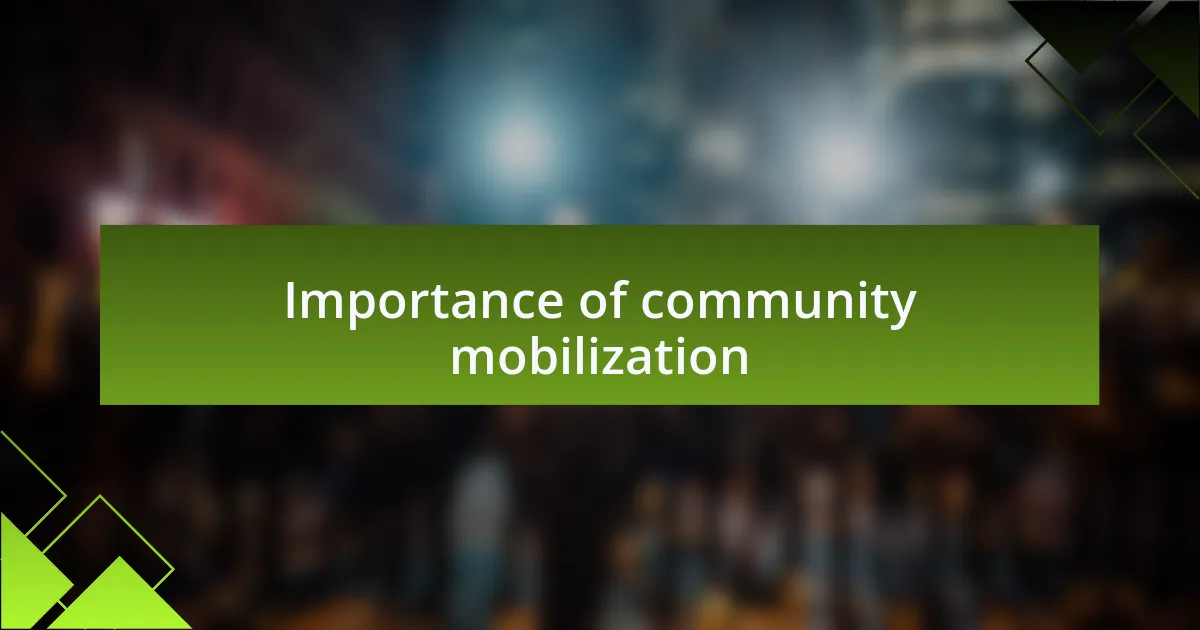
Importance of community mobilization
When I think about the power of community mobilization, I realize it’s about more than just the numbers; it’s about building relationships and solidarity. During one of our community meetings, I saw firsthand how sharing personal stories ignited passion and understanding among attendees. It left me wondering: how many lives could we touch by simply opening the floor for dialogue?
Mobilization also amplifies our voices, highlighting the collective resolve against unjust practices in the justice system. I recall a local rally where people from diverse backgrounds united for a common cause: ending the death penalty. There’s something transformative about standing shoulder to shoulder with others, all driven by a shared belief; it sparks a sense of hope and determination that individual efforts alone often cannot achieve.
Forging connections within the community enables sustained pressure on decision-makers. I remember lobbying city council members alongside fellow activists after countless conversations raised awareness about wrongful convictions in our area. Without that community backbone, the urgency and persistence needed to drive real change could easily fade away. Isn’t it essential that we harness that spirit to reshape the narrative around capital punishment?
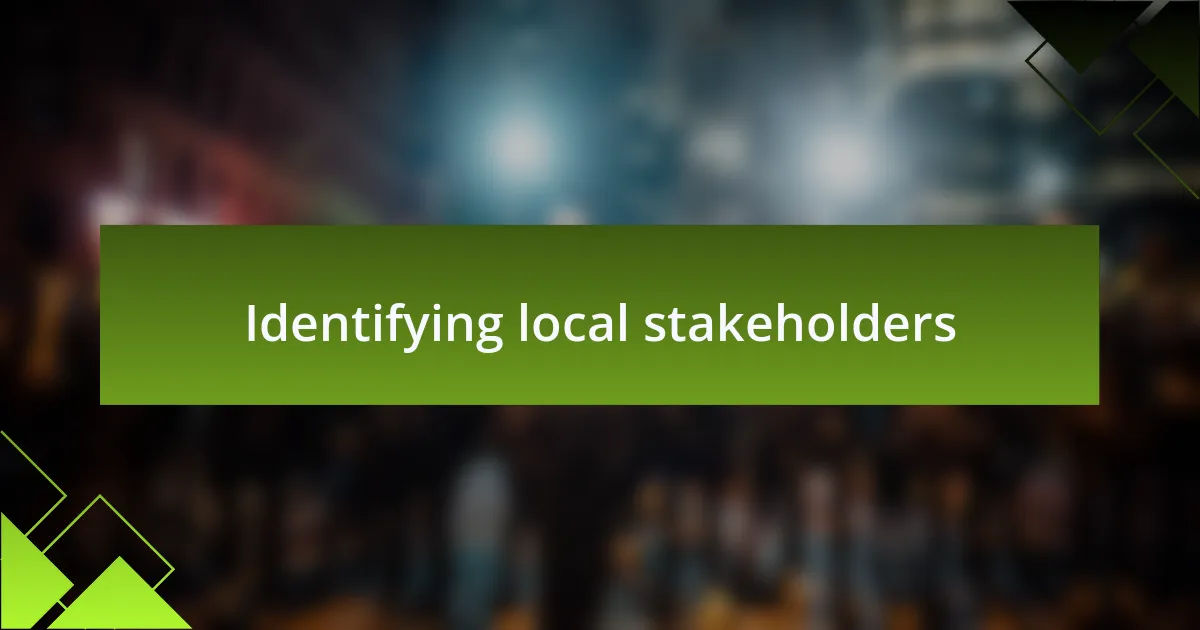
Identifying local stakeholders
Identifying local stakeholders is crucial in mobilizing community efforts against the death penalty. For me, it started at a neighborhood event where I connected with teachers, faith leaders, and local activists who shared a commitment to justice. Their unique perspectives helped me understand the multifaceted nature of our mission—each voice added a potent layer to our overall message.
In my experience, these stakeholders often have their networks and resources, which can significantly amplify our efforts. Last summer, I collaborated with a local pastor who organized a church forum discussing the impact of capital punishment on families. Engaging with these community pillars not only fortified our base but also inspired others to join the conversation. Isn’t it fascinating how one connection can snowball into a movement?
However, it’s not just about identifying who to collaborate with; it’s about recognizing the emotional ties within our community. During a coffee chat with a former death row inmate’s family member, I was struck by their story of loss and resilience. By centering our mobilization around these real experiences, we can create a narrative that resonates deeply, driving home the need for change. Have you ever thought about how your personal network could be a gateway to creating lasting impact?
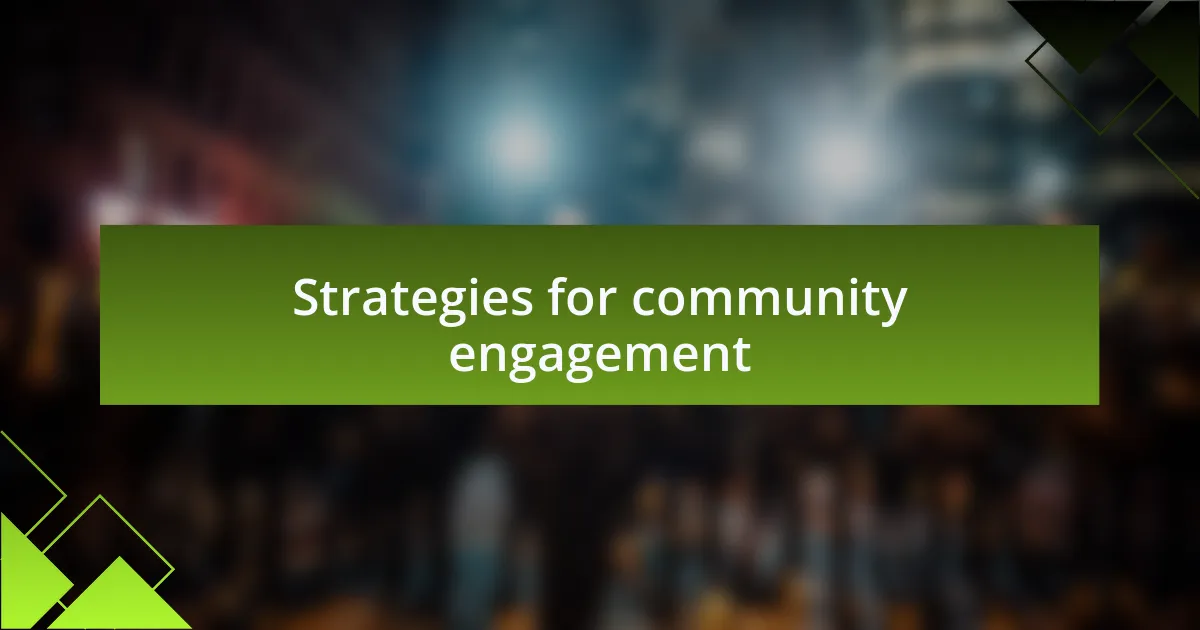
Strategies for community engagement
To effectively engage the community, I found that organizing interactive events is key. I remember hosting a community dinner where we discussed the implications of the death penalty in a casual setting. People were more open to sharing their views when the atmosphere was relaxed, transforming what could have been a dry lecture into a lively dialogue. Have you considered how food can be a universal connector in fostering honest conversations?
Another strategy is leveraging social media platforms to broaden our message. I created a Facebook group dedicated to discussing local anti-death penalty initiatives, which sparked a dialogue beyond our immediate circle. As stories and petitions were shared, community members felt a sense of ownership over the cause. This digital space became a bustling hub where individuals could voice their concerns and share personal experiences—often leading to real-life meetups. Isn’t it empowering to think about how technology can unite us in our shared commitment?
Finally, I’ve learned that storytelling is incredibly powerful. Sharing testimonies from those directly affected by capital punishment can evoke empathy and drive action. At one community meeting, a local activist shared her journey advocating for her brother, who had been wrongfully convicted. The room was silent, yet charged with emotion as her words painted a vivid picture of injustice. Shouldn’t we all strive to lift up these voices and create a narrative that compels others to join our cause?
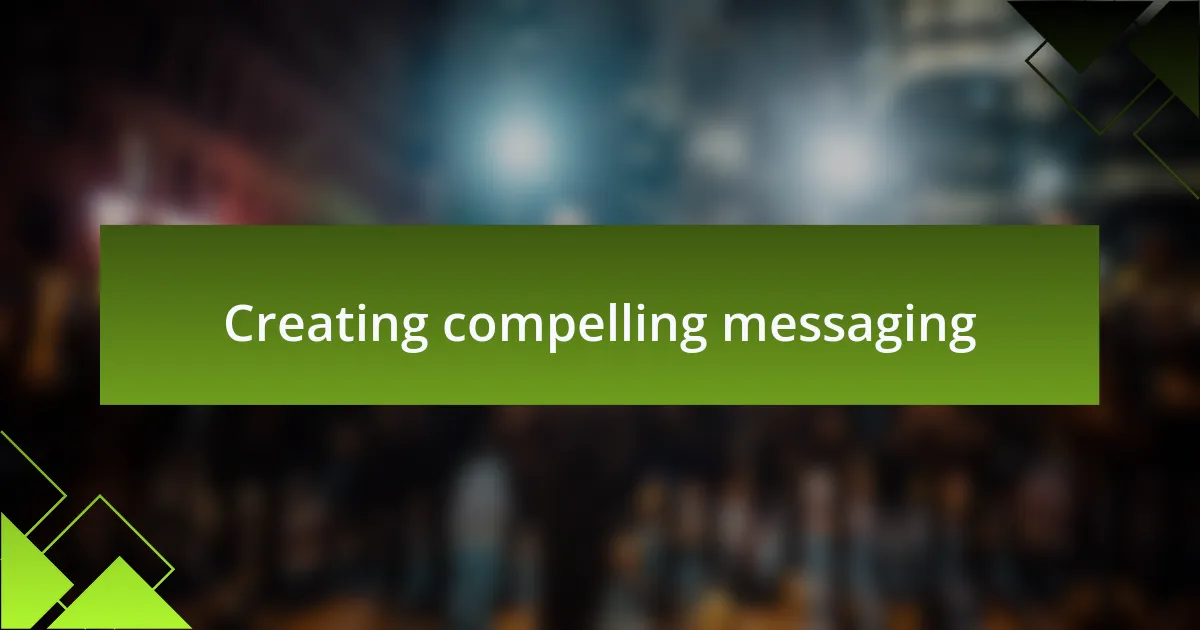
Creating compelling messaging
When creating compelling messaging about the anti-death penalty movement, I have found that simplicity is crucial. One approach I took was to distill complex legal jargon into straightforward language. During a workshop, I transformed dense policy debates into relatable terms, which allowed attendees to grasp the issues without feeling overwhelmed. Have you ever noticed how clarity breeds confidence in a discussion?
In another instance, I crafted a powerful slogan that resonated with local values: “Justice is not revenge.” This phrase sparked conversation and prompted deeper questions about our motivations behind punishment. It reminded me of a time when a community member shared how the slogan struck a chord with his family, leading to heart-to-heart discussions at their dinner table. Isn’t it fascinating how a few carefully chosen words can catalyze intimate connections within families?
Visuals also play a substantial role in ensuring our message sticks. For one campaign, I collaborated with local artists to produce striking graphics that captured the emotional plight of those affected by the justice system. I remember attending a rally where these visuals became the backdrop of powerful testimonies. People walked away not just informed, but moved. How can we use such imagery to further amplify our message and inspire action?
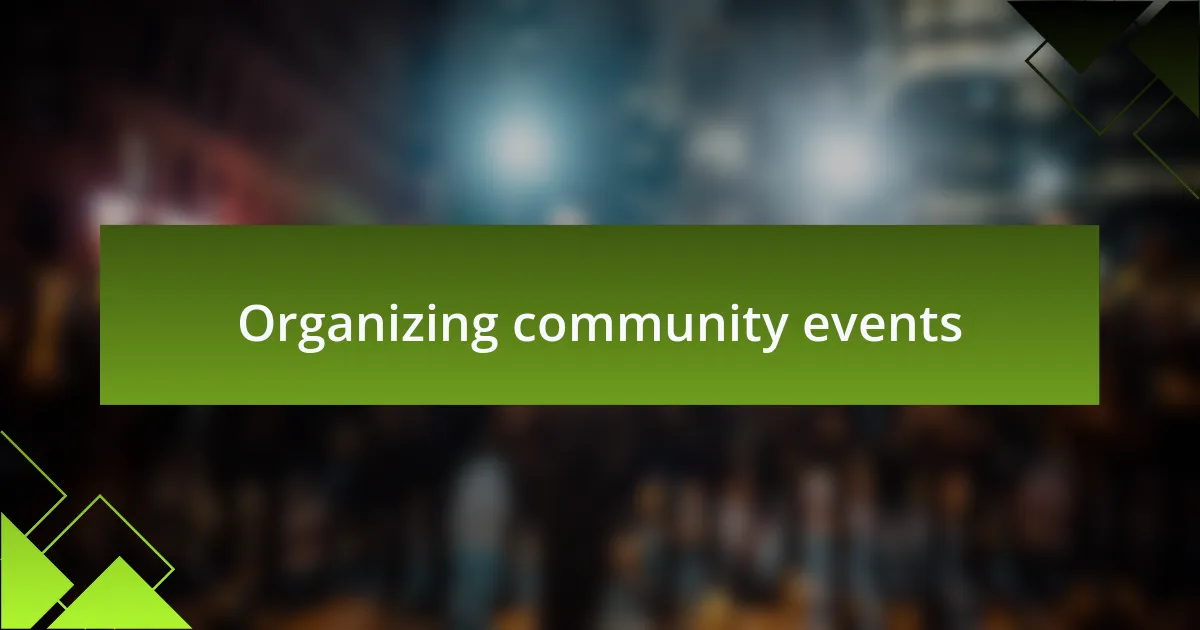
Organizing community events
Organizing community events has been a transformative experience for me and my local advocacy group. One memorable event was our community potluck, where everyone brought their favorite dish while we shared stories of those impacted by the death penalty. I was struck by a woman who spoke so eloquently about her brother’s wrongful conviction; her vulnerability fostered an environment where others felt safe to share their own experiences. How can food and shared stories create a sense of solidarity among those who might otherwise feel isolated?
I also learned the value of incorporating art into our events. At a local fair, we set up a booth where participants could express their feelings about the anti-death penalty movement through art. Watching a young artist paint a mural about hope and redemption was an eye-opening moment for me. It reminded me that creativity is a powerful vehicle for raising awareness and sparking conversations. How can you harness the artistic talents in your community to engage and mobilize others?
Finally, effective community events require planning and collaboration. I remember coordinating with several local organizations for a march that aimed to raise awareness about the flaws in the justice system. The combined efforts not only strengthened our bonds but also showcased our commitment to the cause. Have you ever noticed how working together amplifies our voices and broadens our reach? It’s a reminder that collective action can create substantial change in our communities.